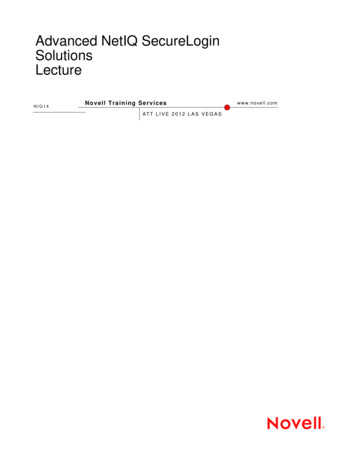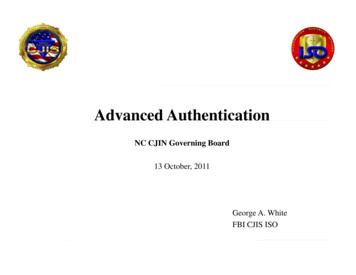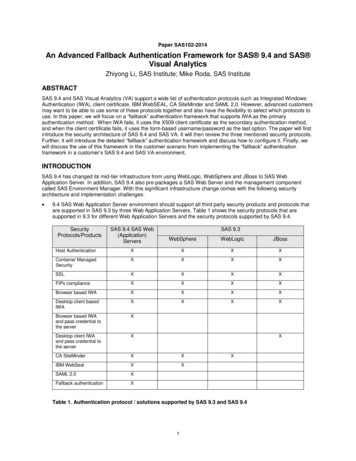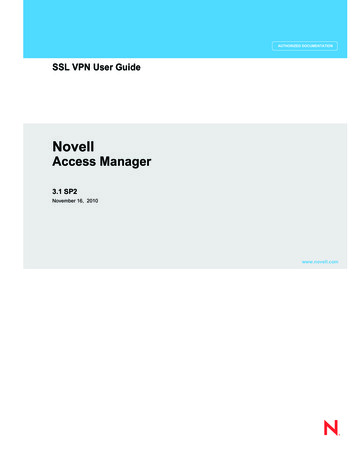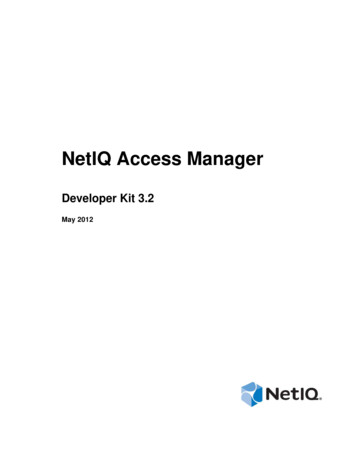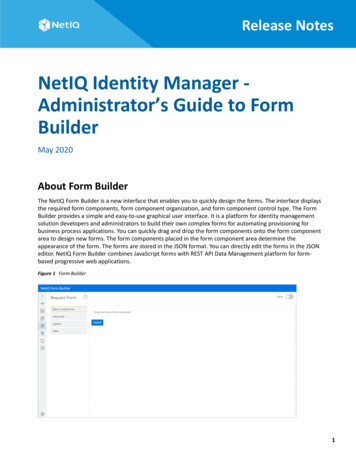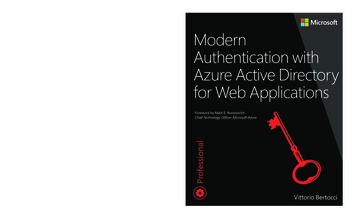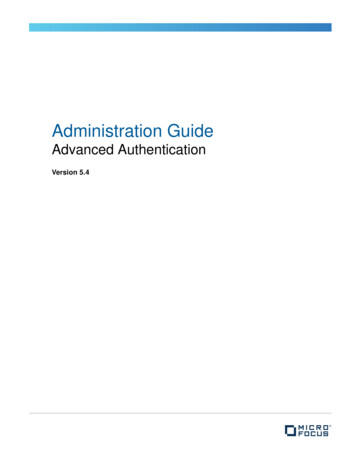
Transcription
Administration GuideAdvanced AuthenticationVersion 5.4
Legal NoticeFor information about legal notices, trademarks, disclaimers, warranties, export and other use restrictions, U.S. Governmentrights, patent policy, and FIPS compliance, https://www.netiq.com/company/legal/.Copyright 2016 NetIQ Corporation, a Micro Focus company. All Rights Reserved.
ContentsAbout NetIQ CorporationAbout this Book571 Advanced Authentication Overview1.11.21.31.49About Advanced Authentication . . . . . . . . . . . . . . . . . . . . . . . . . . . . . . . . . . . . . . . . . . . . . . . . . . . . . . 9Advanced Authentication Server Appliance Functionality . . . . . . . . . . . . . . . . . . . . . . . . . . . . . . . . . . 9Architecture . . . . . . . . . . . . . . . . . . . . . . . . . . . . . . . . . . . . . . . . . . . . . . . . . . . . . . . . . . . . . . . . . . . . . 91.3.1Basic Architecture . . . . . . . . . . . . . . . . . . . . . . . . . . . . . . . . . . . . . . . . . . . . . . . . . . . . . . . . 101.3.2Enterprise Architecture . . . . . . . . . . . . . . . . . . . . . . . . . . . . . . . . . . . . . . . . . . . . . . . . . . . . 101.3.3Enterprise Architecture with Load Balancer. . . . . . . . . . . . . . . . . . . . . . . . . . . . . . . . . . . . . 111.3.4How to Configure Load Balancer for Advanced Authentication Cluster . . . . . . . . . . . . . . . 12Terms . . . . . . . . . . . . . . . . . . . . . . . . . . . . . . . . . . . . . . . . . . . . . . . . . . . . . . . . . . . . . . . . . . . . . . . . . 151.4.1Authentication Method . . . . . . . . . . . . . . . . . . . . . . . . . . . . . . . . . . . . . . . . . . . . . . . . . . . . . 151.4.2Authentication Chain . . . . . . . . . . . . . . . . . . . . . . . . . . . . . . . . . . . . . . . . . . . . . . . . . . . . . . 151.4.3Authentication Event . . . . . . . . . . . . . . . . . . . . . . . . . . . . . . . . . . . . . . . . . . . . . . . . . . . . . . 152 System Requirements173 Advanced Authentication Server Appliance Deployment193.13.23.33.43.53.63.73.8Installing Advanced Authentication Server Appliance . . . . . . . . . . . . . . . . . . . . . . . . . . . . . . . . . . . . 19Configuration Console . . . . . . . . . . . . . . . . . . . . . . . . . . . . . . . . . . . . . . . . . . . . . . . . . . . . . . . . . . . . 203.2.1Configuring Host Name . . . . . . . . . . . . . . . . . . . . . . . . . . . . . . . . . . . . . . . . . . . . . . . . . . . . 203.2.2Configuring HTTP Proxy Server . . . . . . . . . . . . . . . . . . . . . . . . . . . . . . . . . . . . . . . . . . . . . 203.2.3Configuring Appliance Networking. . . . . . . . . . . . . . . . . . . . . . . . . . . . . . . . . . . . . . . . . . . . 203.2.4Configuring Time and NTP Servers . . . . . . . . . . . . . . . . . . . . . . . . . . . . . . . . . . . . . . . . . . . 213.2.5Rebooting Appliance . . . . . . . . . . . . . . . . . . . . . . . . . . . . . . . . . . . . . . . . . . . . . . . . . . . . . . 213.2.6Shutting Down Appliance. . . . . . . . . . . . . . . . . . . . . . . . . . . . . . . . . . . . . . . . . . . . . . . . . . . 21Configuring First Server . . . . . . . . . . . . . . . . . . . . . . . . . . . . . . . . . . . . . . . . . . . . . . . . . . . . . . . . . . . 213.3.1Configuring YubiHSM . . . . . . . . . . . . . . . . . . . . . . . . . . . . . . . . . . . . . . . . . . . . . . . . . . . . . 22First Login To Advanced Authentication Administrative Portal . . . . . . . . . . . . . . . . . . . . . . . . . . . . . . 22Configuring Advanced Authentication Server Appliance . . . . . . . . . . . . . . . . . . . . . . . . . . . . . . . . . . 233.5.1Adding a Tenant . . . . . . . . . . . . . . . . . . . . . . . . . . . . . . . . . . . . . . . . . . . . . . . . . . . . . . . . . . 233.5.2Adding Repository . . . . . . . . . . . . . . . . . . . . . . . . . . . . . . . . . . . . . . . . . . . . . . . . . . . . . . . . 243.5.3Configuring Methods . . . . . . . . . . . . . . . . . . . . . . . . . . . . . . . . . . . . . . . . . . . . . . . . . . . . . . 313.5.4Creating Chain . . . . . . . . . . . . . . . . . . . . . . . . . . . . . . . . . . . . . . . . . . . . . . . . . . . . . . . . . . . 453.5.5Configuring Events. . . . . . . . . . . . . . . . . . . . . . . . . . . . . . . . . . . . . . . . . . . . . . . . . . . . . . . . 463.5.6Managing Endpoints . . . . . . . . . . . . . . . . . . . . . . . . . . . . . . . . . . . . . . . . . . . . . . . . . . . . . . 583.5.7Configuring Policies . . . . . . . . . . . . . . . . . . . . . . . . . . . . . . . . . . . . . . . . . . . . . . . . . . . . . . . 603.5.8Configuring Server Options . . . . . . . . . . . . . . . . . . . . . . . . . . . . . . . . . . . . . . . . . . . . . . . . . 703.5.9Adding License . . . . . . . . . . . . . . . . . . . . . . . . . . . . . . . . . . . . . . . . . . . . . . . . . . . . . . . . . . 70Default Ports for Advanced Authentication Server Appliance . . . . . . . . . . . . . . . . . . . . . . . . . . . . . . 71Configuring a Cluster . . . . . . . . . . . . . . . . . . . . . . . . . . . . . . . . . . . . . . . . . . . . . . . . . . . . . . . . . . . . . 723.7.1Registering a New Site . . . . . . . . . . . . . . . . . . . . . . . . . . . . . . . . . . . . . . . . . . . . . . . . . . . . 733.7.2Registering a New Server . . . . . . . . . . . . . . . . . . . . . . . . . . . . . . . . . . . . . . . . . . . . . . . . . . 743.7.3Resolving Conflicts . . . . . . . . . . . . . . . . . . . . . . . . . . . . . . . . . . . . . . . . . . . . . . . . . . . . . . . 76Authentication Methods Enrollment . . . . . . . . . . . . . . . . . . . . . . . . . . . . . . . . . . . . . . . . . . . . . . . . . . 76Contents3
4 Advanced Authentication Server Maintenance4.14.24.3Reporting . . . . . . . . . . . . . . . . . . . . . . . . . . . . . . . . . . . . . . . . . . . . . . . . . . . . . . . . . . . . . . . . . . . . . . 79Logging . . . . . . . . . . . . . . . . . . . . . . . . . . . . . . . . . . . . . . . . . . . . . . . . . . . . . . . . . . . . . . . . . . . . . . . 80Upgrading Advanced Authentication . . . . . . . . . . . . . . . . . . . . . . . . . . . . . . . . . . . . . . . . . . . . . . . . . 915 Troubleshooting5.15.25.35.45.55.647993Fatal error while trying to deploy ISO file and install in graphic mode . . . . . . . . . . . . . . . . . . . . . . . . 93Partition Disks . . . . . . . . . . . . . . . . . . . . . . . . . . . . . . . . . . . . . . . . . . . . . . . . . . . . . . . . . . . . . . . . . . 93Networking Is Not Configured . . . . . . . . . . . . . . . . . . . . . . . . . . . . . . . . . . . . . . . . . . . . . . . . . . . . . . 94Error "Using a password on the command line interface can be insecure" . . . . . . . . . . . . . . . . . . . . 94The ON/OFF Switch Is Broken If the Screen Resolution Is 110% . . . . . . . . . . . . . . . . . . . . . . . . . . . 94Error When Requesting For Update. . . . . . . . . . . . . . . . . . . . . . . . . . . . . . . . . . . . . . . . . . . . . . . . . . 95Advanced Authentication - Administration
About NetIQ CorporationWe are a global, enterprise software company, with a focus on the three persistent challenges in yourenvironment: Change, complexity and risk—and how we can help you control them.Our ViewpointAdapting to change and managing complexity and risk are nothing newIn fact, of all the challenges you face, these are perhaps the most prominent variables that denyyou the control you need to securely measure, monitor, and manage your physical, virtual, andcloud computing environments.Enabling critical business services, better and fasterWe believe that providing as much control as possible to IT organizations is the only way toenable timelier and cost effective delivery of services. Persistent pressures like change andcomplexity will only continue to increase as organizations continue to change and thetechnologies needed to manage them become inherently more complex.Our PhilosophySelling intelligent solutions, not just softwareIn order to provide reliable control, we first make sure we understand the real-world scenarios inwhich IT organizations like yours operate—day in and day out. That's the only way we candevelop practical, intelligent IT solutions that successfully yield proven, measurable results. Andthat's so much more rewarding than simply selling software.Driving your success is our passionWe place your success at the heart of how we do business. From product inception todeployment, we understand that you need IT solutions that work well and integrate seamlesslywith your existing investments; you need ongoing support and training post-deployment; and youneed someone that is truly easy to work with—for a change. Ultimately, when you succeed, weall succeed.Our Solutions Identity & Access Governance Access Management Security Management Systems & Application Management Workload Management Service ManagementAbout NetIQ Corporation5
Contacting Sales SupportFor questions about products, pricing, and capabilities, contact your local partner. If you cannotcontact your partner, contact our Sales Support team.Worldwide:www.netiq.com/about netiq/officelocations.aspUnited States and Canada:1-888-323-6768Email:info@netiq.comWeb Site:www.netiq.comContacting Technical SupportFor specific product issues, contact our Technical Support spNorth and South America:1-713-418-5555Europe, Middle East, and Africa: 353 (0) 91-782 677Email:support@netiq.comWeb Site:www.netiq.com/supportContacting Documentation SupportOur goal is to provide documentation that meets your needs. The documentation for this product isavailable on the NetIQ Web site in HTML and PDF formats on a page that does not require you to login. If you have suggestions for documentation improvements, click Add Comment at the bottom ofany page in the HTML version of the documentation posted at www.netiq.com/documentation. Youcan also email Documentation-Feedback@netiq.com. We value your input and look forward tohearing from you.Contacting the Online User CommunityNetIQ Communities, the NetIQ online community, is a collaborative network connecting you to yourpeers and NetIQ experts. By providing more immediate information, useful links to helpful resources,and access to NetIQ experts, NetIQ Communities helps ensure you are mastering the knowledge youneed to realize the full potential of IT investments upon which you rely. For more information, visitcommunity.netiq.com.6Advanced Authentication - Administration
About this BookThis Administration Guide is intended for system administrators and describes the procedure ofAdvanced Authentication Server appliance configurations and deployment.Intended AudienceThis book provides information for individuals responsible for understanding administration conceptsand implementing a secure, distributed administration model.About this Book7
8Advanced Authentication - Administration
1Advanced Authentication Overview1This chapter contains the following sections: Section 1.1, “About Advanced Authentication,” on page 9 Section 1.2, “Advanced Authentication Server Appliance Functionality,” on page 9 Section 1.3, “Architecture,” on page 9 Section 1.4, “Terms,” on page 151.1About Advanced AuthenticationAdvanced Authentication is a software solution that enhances the standard user authenticationprocess by providing an opportunity to logon with various types of authenticators.Why choose Advanced Authentication ?Advanced Authentication . .makes the authentication process easy and secure (no complex passwords, “secret words”,etc.) .prevents unauthorized use of your computer .protects you from fraud, phishing and similar illegal actions online .can be used to provide secure access to your office1.2Advanced Authentication Server ApplianceFunctionalityBenefits of using Advanced Authentication Server appliance are evident. Advanced AuthenticationServer appliance. .is cross-platform .contains an inbuilt RADIUS server .supports integration with Advanced Authentication Access Manager .does not require scheme extending .provides administrators with a capability of editing the configured settings through web-basedAdvanced Authentication Administrative Portal1.3ArchitectureIn this chapter: Basic Architecture Enterprise Architecture Enterprise Architecture with Load BalancerAdvanced Authentication Overview9
1.3.1Basic ArchitectureThe basic architecture of the Advanced Authentication is simple and requires only one AdvancedAuthentication Server. You can use it for testing and proof of concepts.Advanced Authentication Server is connected to a Directory that can be an Active Directory DomainServices, NetIQ eDirectory, Active Directory Lightweight Directory Service or other compliant LDAPdirectories. An Event Endpoint can be Windows, Linux or Mac OS X machine, NetIQ AccessManager, NetIQ CloudAccess, or RADIUS Client to authenticate through the RADIUS Server that isbuilt-in the Advanced Authentication Server. For a complete list of supported events, see ConfiguringEvents.1.3.2Enterprise ArchitectureThe Enterprise architecture of the Advanced Authentication contains sites that can be created fordifferent geographical locations. For example, the following illustration displays two AdvancedAuthentication sites. Site A is the first site created for headquarters in New York. Site A’s firstAdvanced Authentication Server contains the Global Master and Registrar roles. This server containsa master database and it can be used to register new sites and servers.NOTE: If the Global Master is down, new sites cannot be added.Site B is created for the office in London and it contains the identical structure. The master server inanother site has DB Master role. DB Masters interacts with the Global Master.DB Server provides a DB Slave database that is used for backup and fail-over. You can create amaximum of two DB Slave Servers per site that can be DB Server 1 and DB Server 2. When the DBMaster is unavailable, the DB Slave node responds to the database requests. When the DB Masterbecomes available again, the DB Slave node synchronizes with the DB Master and the DB Masterbecomes the primary point of contact for database requests again.Endpoints can interact with every server that contain a database.NOTE: Master Servers connect to each other directly. If the Global Master is down, others willreplicate.A Global Master must have a connection to each of the LDAP servers. Hence in a datacenter withGlobal Master, you must have LDAP servers for all the used domains.IMPORTANT: Please ensure to take regular snapshots or to clone the primary Site to protect fromany hardware issues or any other accidental failures. It is recommended to do it each time after youchange the configuration of repositories, methods, chains, events and policies or add/remove serversin the cluster.10Advanced Authentication - Administration
You can convert DB Slave of primary site to Global master. This requires corresponding DNSchanges. Nothing can be done if Global Master and all slaves are lost.1.3.3Enterprise Architecture with Load BalancerThe Enterprise architecture with Load balancer contains a more complicated architecture incomparison with the Enterprise Architecture. The architecture contains the following components: Web Servers: Web Server does not contain a database. It responds to the authenticationrequests and connects to the DB Master database. You need more Web Servers to serve moreworkload. There is no limitation for Web Servers. Load Balancer: It provides an ability to serve authentication requests from the ExternalEndpoints. Load Balancer is a third-party component. It is located in DMZ and can be configuredto interact with all the Advanced Authentication Servers.Advanced Authentication Overview11
1.3.4How to Configure Load Balancer for AdvancedAuthentication ClusterLoad balancer can be installed and configured via third party software. Below is an example of how toinstall and configure nginx as load balancer on Ubuntu 14.Target configuration:12HostnameIP addressRoleOperation SystemDomain controllerwin-dc192.168.1.42AD DS, DNSWindows Server 2008R2AA v5 masternaafmaster192.168.1.43AA Master serverAA v5Advanced Authentication - Administration
HostnameIP addressRoleOperation SystemAA v5 slavenaafslave192.168.1.41NAAF Slave serverAA v5Load balancerloadbalancer192.168.1.40Nginx load balancerUbuntu 14Before starting the configuration, please make sure that the following requirements are fulfilled: Repository is configured in Advanced Authentication appliance. Both Advanced Authentication servers are installed and configured as Master and Slave. Appropriate entries are added to DNS. Ubuntu 14 is installed.To configure Load Balancer for Advanced Authentication cluster, it is required to install nginx onUbuntu 14 and configure it.Installing nginx on Ubuntu 14To install nginx on Ubuntu 14, follow the steps:1. Open the following source list: sudo nano /etc/apt/sources.list2. Add necessary entries: deb http://nginx.org/packages/ubuntu/ trusty nginx deb-src http://nginx.org/packages/ubuntu/ trusty nginx3. Update repository and install nginx: apt-get update apt-get install nginx4. Start nginx and make sure that web server is working: sudo service nginx restart5. Open your browser and go to web server http://192.168.1.40 or http://loadbalancer.Configuring nginxThe following load balancing mechanisms/methods are supported in nginx: round-robin - requests to the application servers that are distributed in a round-robin fashion least-connected - next request assigned to the server with the least number of activeconnections ip-hash - a hash-function that is used to determine what server should be selected for the nextrequest (based on the client’s IP address)This article describes only round-robin configuration. To configure nginx, follow the steps:1. Backup original configuration file: sudo cp /etc/nginx/nginx.conf /etc/nginx/nginx.conf original.2. Open the nginx.conf file and replace with following:Advanced Authentication Overview13
user nginx;error log /var/log/nginx/error.log warn; # error log locationpid /var/run/nginx.pid; # process id file# limit number of open sockets. Debian default max is 1024, ensure nginx notopen all the sockets.worker processes 1;events {worker connections 900; # 512 is default}# worker processes auto; # ssl needs CPUhttp {include /etc/nginx/mime.types;default type application/octet-stream;log format main ' remote addr - remote user [ time local] " request" '' status body bytes sent " http referer" ''" http user agent" " http x forwarded for"';access log /var/log/nginx/access.log main; # access log locationsendfile on;# keepalive default is 75# keepalive timeout 10;gzip on;gzip static on;gzip comp level 5;gzip disable msie6;gzip min length 1000;gzip proxied expired no-cache no-store private auth;gzip vary on;gzip types text/plain text/css application/json application/javascripttext/xml application/xml application/rss xml application/atom xml;ssl certificate /etc/nginx/cert.pem;ssl certificate key /etc/nginx/cert.pem;ssl session cache shared:SSL:2m; # 1m stores 4000 sessions, default expire 5minssl protocols TLSv1 TLSv1.1 TLSv1.2; # disable TLSv3 - POODLE vulnerabilityresolver 192.168.1.42 valid 300s ipv6 off; # ip address of DNSresolver timeout 10s;upstream web {#server naafmaster.company.local:443 resolve;#server naafslave.company.local:443 resolve;server 192.168.1.43:443;server 192.168.1.41:443;}server {#listen 80;listen 443 ssl;location / {proxy pass https://web;proxy set header HOST host;proxy set header X-Forwarded-Proto scheme;proxy set header X-Real-IP remote addr;proxy set header X-Forwarded-For proxy add x forwarded for;}}}3. Copy certificate from any Advanced Authentication server in cluster from the directory /etc/nginx/cert.pem to the same directory on load balancer.4. Go to https://loadbalancer/admin page and make sure that
Advanced Authentication Server is connected to a Directory that can be an Active Directory Domain Services, NetIQ eDirec
